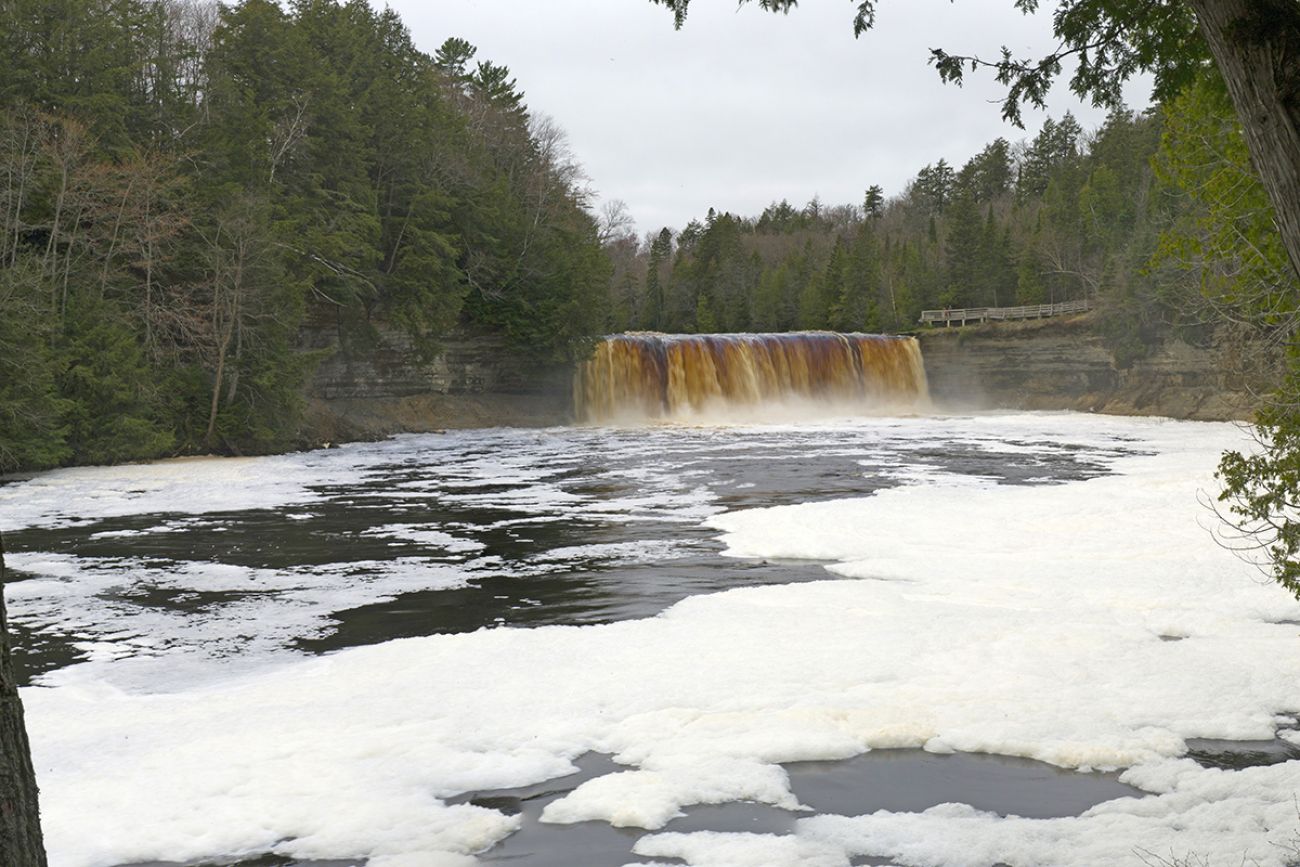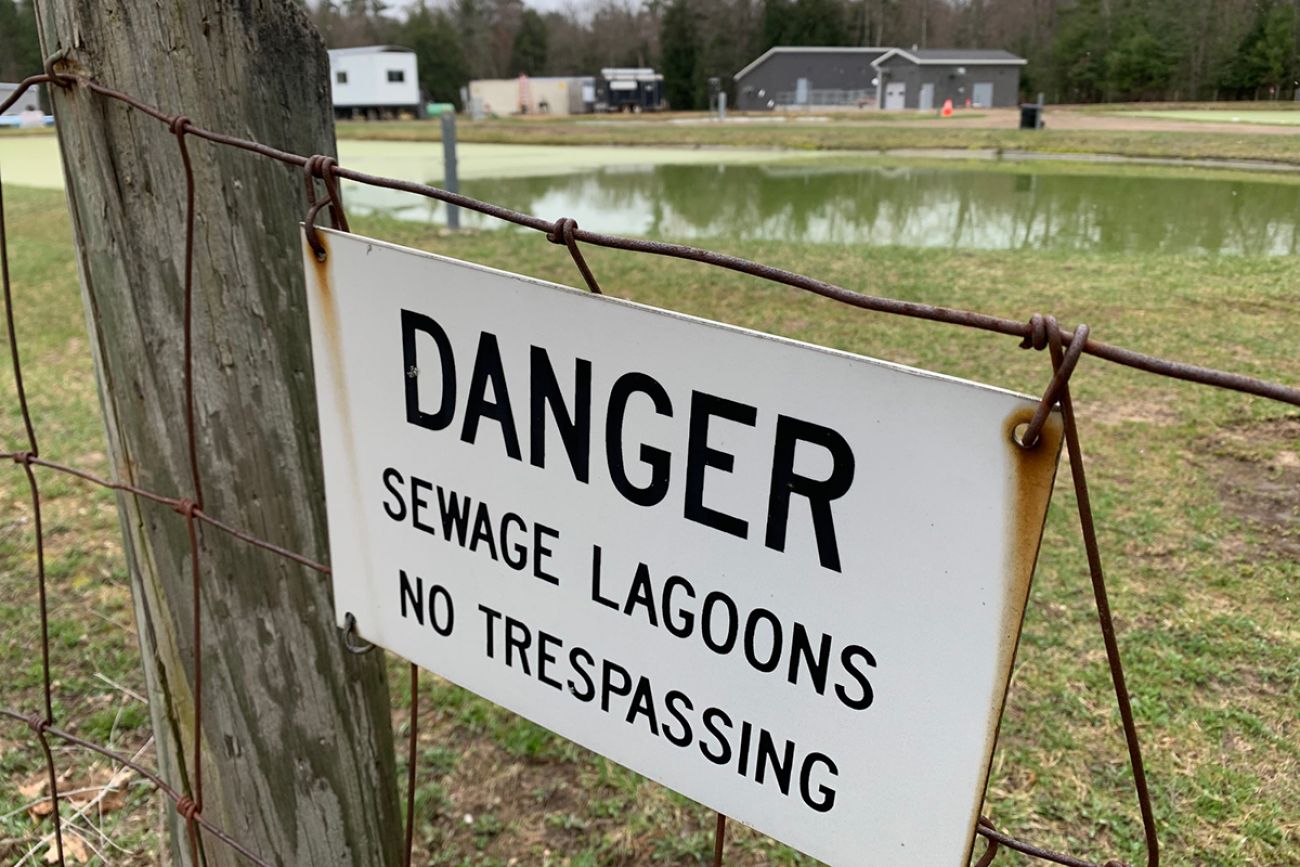
By Kelly House, Bridge Michigan
The Great Lakes News Collaborative includes Bridge Michigan; Circle of Blue; Great Lakes Now at Detroit Public Television; and Michigan Radio, Michigan’s NPR News Leader; who work together to bring audiences news and information about the impact of climate change, pollution, and aging infrastructure on the Great Lakes and drinking water. This independent journalism is supported by the Charles Stewart Mott Foundation. Find all the work HERE.
Jim Sjoberg is so fond of P.J. Hoffmaster State Park, he asked his wife Kelsey to marry him among the park’s towering Lake Michigan dunes.
But there’s one thing he doesn’t love about this popular forested park just south of Muskegon.
“If anyone’s got a car that’s worth keeping around for a few years, it’s not fun to drive in,” Sjoberg said. More often than not, “I don’t even bother, because I know it’s gonna put a toll on my suspension.”

Jim and Kelsey Sjoberg live near P.J. Hoffmaster State Park, south of Muskegon, and got engaged there. But the park’s terrible roads are a barrier to visiting more often. (Courtesy photo)
To reach the forested dunes and sandy beach, visitors must endure a spine-rattling journey along the snaking road into the park. The pavement is riddled with potholes that have been patched and re-patched for years, as parks staff awaited enough money for a badly-needed repave.
The day has finally come.
Fixing the road to Hoffmaster is just one of the 188 tasks state parks leaders hope to complete over the next few years, after lawmakers last month approved using nearly $220 million of the federal COVID-19 stimulus funds to shrink a maintenance backlog that has piled up over decades.
Another $30.2 million will be used to develop a new state park in Flint, at the site of the former “Chevy in the Hole” Chevrolet factory near downtown Flint.
Houghton County’s Lake Linden trail will finally be fully-repaired after the 2018 Father’s Day floods washed out a large section. Sleepy Hollow State Park north of Lansing is getting new toilet and shower buildings. The old town site at Fayette Historic State Park, southwest of Manistique on the Garden Peninsula, will be restored.
The coming investments in parks and trails scattered throughout both peninsulas are “a long time coming,” said Ron Olson, parks chief for the Michigan Department of Natural Resources.
And the timing couldn’t be better: Michigan parks are primed for another year of pandemic-induced high visitation, and Olson called it “embarrassing” when those visitors are forced to drive rickety roads, navigate inaccessible bathrooms or abruptly change camping plans when aging park equipment gives out.

The viewing platforms at Tahquamenon Falls State Park will soon be upgraded, one of several projects planned at the eastern Upper Peninsula park. (Photo courtesy of Michigan DNR)
But in a time of rapid inflation, the burst of federal money won’t be a cure-all. Legislators are considering a budget proposal from Gov. Gretchen Whitmer that would add money and staff to tackle additional work and boost pay as state parks struggle to recruit workers in a changing economy.
The mundane and magnificent
Parks leaders have until 2024 to decide how to spend the federal funds, and another two years to complete all projects.
“We don’t want to leave a dime on the table,” Olson said, so they’ve been racing to get project plans in order, and will break ground on some as soon as the summer tourism season ends.
There are a handful of splashy items on the to-do list: Tahquamenon Falls State Park in the Upper Peninsula, among the state’s most popular, will get $4.2 million to upgrade viewing platforms overlooking the iconic falls, improve accessibility for those with physical disabilities, replace toilet and shower buildings and improve roads.
And at Detroit’s Belle Isle, the majestic glass dome at Anna Scripps Whitcomb Conservatory will get a major upgrade.
The $10 million project, $7.5 million of which will come from federal COVID stimulus dollars while a private donor covers the rest, includes replacing all of the glass in the conservatory’s upper dome, painting the steel trusses that support it, and upgrading ventilation for the conservatory’s exotic plants.
It’s a time-critical project, said Amanda Treadwell, an urban field planner for the state parks system: A 2017 report warned that the dome, built in 1904, needed major renovations to remain safe for public use. Among the issues identified at the time, Treadwell said: Gaps in the steel trusses that “you could stick a pencil through.” Asbestos in the glass dome. Lead paint.
“If it wasn’t taking place by this time,” Treadwell said, “the recommendation was to close it to the public.”
The work could start as soon as this fall (the building will be closed to the public during construction), followed by a $4.75 million roof replacement for Belle Isle’s casino, a Renaissance Revival building opened on Detroit’s riverfront island in 1908.
Beyond those highly-visible projects, the bulk of the state parks windfall will go toward mundane-but-essential tasks: Repaving roads, replacing wastewater facilities, and updating electrical systems that are too weak to power big modern motorhomes.
“It’s about fixing some of these chronic things that have just been tolerated and repaired for over the years,” Olson said.
All told, roads and parking areas will get $35 million in new investment, while park buildings will get $59 million. Another $55 million will go to upgrading electricity, water and sewer systems, with $38 million for trail maintenance.
Other shovel-ready project that could begin as soon as this year include:
- Porcupine Mountains Wilderness State Park: A $3.8 million renovation of historic buildings and upgrades to sewers, roads and other facilities
- Algonac State Park: $2.5 million for roads and campgrounds
- Cheboygan State Park: $2.7 million for campgrounds and water and sewer systems
- Hartwick Pines State Park: $1 million to renovate the historic log Memorial Building constructed by the Civilian Conservation Corps
At Interlochen State Park, which contains Michigan’s biggest state park campground, sewage lagoons used to treat wastewater are outdated and undersized. A new, first-of-its-kind sewage treatment plant will have more capacity and better treatment technology, said Maia Turek, resource development specialist for the DNR Parks and Recreation Division.

The sewage lagoons at Interlochen State Park, south of Traverse City, will be replaced with a new modern treatment system after lawmakers approved nearly $220 million to tackle Michigan’s state parks maintenance backlog. (Photo courtesy of Maia Turek)
It’s the kind of infrastructure that park-goers don’t notice unless it fails. And failures have become more common: At other state parks, Turek said, malfunctioning sewage systems have forced campers to use porta-johns or abruptly find other lodging.
And at Interlochen, 30-amp electricity pedestals, which weren’t designed to provide electricity to some modern RVs that require more juice, have at times melted under the strain of overuse.
Those will be upgraded, as will old bathrooms that are accessible only to people spry enough to step over the several-inches-tall concrete ledge beneath the doorway.
“If I was in a wheelchair, or I had mobility challenges because I had a new hip, entering the facilities is impossible without assistance,” Turek said. “And that’s not at all what we stand for.”
In Flint, the coming development of the former Chevy In the Hole site will end Genesee County’s run as Michigan’s only county without state parkland. Lottie Ferguson, the city’s chief resilience officer, called the new park “a win for Flint,” pointing to its potential to boost economic value, promote environmental protection and improve residents’ quality-of-life.
Locally run parks and recreation efforts also get a cut of the $4.7-billion infrastructure spending deal Gov. Gretchen Whitmer and state Republican lawmakers struck in March. Recreational greenways in Detroit and Grand Rapids will get $60 million and $55 million, respectively. Another $20 million will fund sports-related tourism and recreation in northern Michigan, and $65 million in grants to local parks throughout the state.
“You can’t do everything”
Even with the massive funding boost, the state parks system won’t clear every item from its repair and maintenance to-do list.
At last count, the system was facing a $264 million maintenance backlog. That number is likely closer to $300 million now, Olson said, leaving $80 million-worth of needs that won’t be covered by the COVID stimulus windfall.
Construction costs are rising steeply, Olson said, and bids on recent projects have come in high. If planned projects go over budget, parks officials will be forced to pare down their plan to spend the federal money.
“You can’t do everything,” Olson said. “But this will be a humongous step forward.”
Parks officials are also hoping for budget boosts in the coming fiscal year to tackle other maintenance projects and boost staff pay as low wages for summer workers leaves the parks system struggling to compete against McDonald’s for workers.
Whitmer’s proposed DNR budget for the next fiscal year includes a $9.8 million plus authorization for dozens of new staff, as part of a push to raise parks wages and hire more rangers. A draft House budget would eliminate those items, while a Senate draft would keep the money but scrap the staffing increase.
Catch more news at Great Lakes Now:
Indiana Dunes National Park entry fee to begin March 31
Say Goodbye to Your National Parks Road Trips?
Featured image: A $10-million upgrade to the Belle Isle Conservatory could start as soon as this fall, funded mostly by federal funds allocated to state parks last month. (Photo courtesy of Michigan DNR)
1 Comment
-
I am pleased to see the upgrades you will be able to make with the federal dollars, but I feel it is very important to have internet or atleast phone coverage in the parks. Not just for convenience but for safety! Please consider this a necessity rather than a “nice” service to have.




